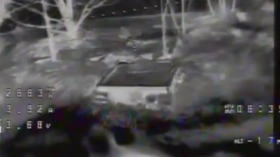Police start using ‘black boxes’ in car crash investigations

Nearly every car being manufactured right now comes with a little added bonus by way of a tiny recording device nestled under the center console. And if you’re looking to keep your driving habits under wraps, you might want to start worrying.
As many as 96 percent of the cars mass-produced in 2013 include event data recorders, or EDRs, yet the existence of these small “black box” surveillance devices are rarely known among the automobile drivers whose data is being collected with every quick turn of the steering wheel.
Despite widespread ignorance of the EDRs, though, they could soon become mandatory. The US Department of Transportation's National Highway Traffic Safety Administration is asking that the installation of EDRs in light passenger vehicles be mandatory starting September 2014, and opponents are already attempting to raise awareness in order to make auto drivers aware that their sudden speed bursts and even seatbelt data is being collected and could be easily shared.
But with little safeguards in place, the still emerging technology is raising a lot of questions about what can legally be collected and who can access that information.
“These cars are equipped with computers that collect massive amounts of data,” Khaliah Barnes of the Electronic Privacy Information Center told the New York Times for an article published on Sunday. “Without protections, it can lead to all kinds of abuse,” she said.
When Barnes caught up with CBS This Morning earlier this year, she said that only 13 states have so far implemented rules which make that data the property of the driver, preventing it from being picked at and put under analysis without proper consent. Barnes admitted that the majority of states don’t have these privacy safeguards, though, and the result is rearing the data of everyone else available to third-parties with little protection.
“There’s not so much privacy concerns as actual threats to privacy,” Barnes told CBS. “These machines collect lots of data, and right now there are no federal laws that safeguard this information. And so what happens is there is an increasing market for this information. Law enforcement wants to see this information. Insurance companies, as well as private citizens involved in litigation.”
But what kind of data is recorded exactly? Standard EDRs don’t log the identity or actions of specific persons in cars, per se, but they are able to provide investigators insight with what happened moments before a collision. When they were first rolled out, though, that wasn’t the plan.
"It was never designed for investigative purposes," Dave Wells of the King County Sheriff's Office in Washington state told National Public Radio. "It was designed for ... motor vehicle safety and keeping people less injured and alive."
Depending on the type of EDR, these black boxes can record the speed of a vehicle, the crash force at the moment of impact and an array of other information about the automobile’s inner workings.
“It really just takes a snapshot of the event,” John Giamalvo of Edmunds.com told CBS News.
Other information that can be collected and then shared includes whether or not the car’s brake was activated before the crash, the state of the engine and whether the vehicle seat belt was buckled before an incident.
"More often than not, the data from this is going to help them in an accident," Giamalvo said. "It's at least going to point out one thing, and that's the facts."
Those facts played an important role in the 2011 crash of the Ford Crown Victoria operated by Timothy Murray, who at the time was the lieutenant governor of Massachusetts. He smashed his government-issued automobile and survived without serious injuries, but initially told police that he had been wearing his seatbelt and driving at a safe speed. Data removed from the black box later proved him inaccurate on both accounts. Murray later admitted to falling asleep at the wheel before his car crashed at a speed of over 100 miles an hour.
But because laws differ from state to state, Murray’s ability to keep investigators from collecting that data proved to be futile. Massachusetts is one of the many states that have failed to pass legislation outlining who can control and access that data, meaning millions of automobiles can be subjected to spontaneous analysis if the right paperwork is written up.
Under the proposal that the NHTSA hopes to have on the books by the end of next year, automobile manufacturers will be mandated to provide a commercially available tool for copying the data collected by EDRs.














